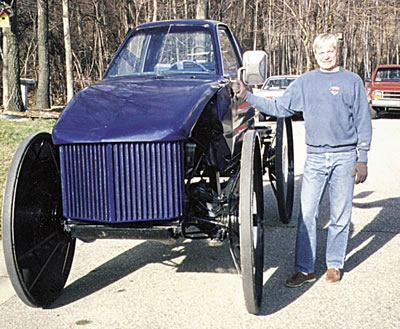Thin-Wheel Sprayer Built For Cut-Down Plants
 Larry Hall, Clarkston, Mich., wanted to build a sprayer that would let him work in solid-seeded standing crops without doing damage. So he turned a 1982 Chevy Luv pickup into a narrow-wheel sprayer equipped with 2 1/2-in. wide steel wheels.
Larry Hall, Clarkston, Mich., wanted to build a sprayer that would let him work in solid-seeded standing crops without doing damage. So he turned a 1982 Chevy Luv pickup into a narrow-wheel sprayer equipped with 2 1/2-in. wide steel wheels.
The outer edge of the 4-ft. high wheels are covered by a band of 1 1/2-in. thick rubber. A 110-gal. tank and 40-ft. boom mount on back of the 4-WD pickup. Hall "narrowed-up" the cab and hood by cutting 20 in. out of the center of it because the tall wheels needed more room for turns. The cab on the truck is now only 30 in. wide. He didn't modify the truck frame at all. He uses the rig, which he painted Corvette blue, mainly to spray postemergence herbicides on drilled soybeans.
"It looks like a swamp buggy but it works great. I can use it on full-grown soy-beans up to 1 1/2 ft. high," says Hall. "It knocks down some plants but they soon re-cover. I can go any direction in the field without doing much damage. This year I planted Roundup-ready soybeans and used the rig to spray Roundup when beans were only 6 to 8 in. high. I sit up high and have a good view in front of me. It's small and lightweight so it reduces compaction - the boom weighs only 100 lbs. I didn't have to relocate any controls or the steering column.
"The cab and hood extend only 1 in. past the frame compared to about 1 ft. on the original pickup which provides more room for the big wheels to turn. I can turn as short as I could before with the original wheels. There's room for another passenger but it's very tight. It'll go up to 40 mph, and I never have to worry about getting a flat tire. I spent about $4,000 to build it."
Hall paid $250 for the pickup which had a wrecked front end. He removed the bed and replaced the original engine with a 2.2-liter Isuzu diesel engine. He used a cutting torch to cut 20 in. out of the center of the cab all the way down through the floor, moved the two sides in, and welded them back together. He also removed 20 in. from the windshield. He used a glass cutter to score and break it, then moved the two halves in and used urethane to glue them together. He had a new rear window made at a glass shop. He had to remove the hump over the transmission. To make room under the floor of the cut-down cab for the trans-mission he raised the cab about 7 in. He welded a pair of steel mounting plates onto the frame and bolted the cab to them, using the original mounting bolts.
With the cab moved in, the steering column came out directly behind the engine about 1 ft. from the steering gear. To solve the problem he cut the bottom of the steering column off at the firewall and welded a sprocket onto it, then welded another sprocket onto the steering gear and used a chain to connect them together.
He had some friends fabricate a new hood to match the narrowed-up cab. He wanted to keep the instrument cluster on the dash where it was so instead of cutting through the middle of the dash he just re-moved the right side. He also cut 20 in. out of the seat, head liner, and carpet. He mounted the steel wheels on the original wheel hubs. To reinforce the wheels he welded twelve 3/16-in. thick, 1-in. dia. steel rods diagonally from the inside edge of each hub to the outside of each wheel. He had a shop mount the rubber bands on the wheels. A pair of wires runs through each band.
"It took longer than I thought it would but it turned out nice," says Hall. "I didn't narrow up the axles because the raised cab makes it a little top heavy. The steel wheel - rubber band construction method is the same one used by the Amish on their equipment. I installed a bigger radiator because I have to run slow while spraying and the crop comes up right against the radiator which reduces air flow. The big wheels have three times as much circumference area as normal wheels so to compensate I keep the 4-speed tranmission in low gear."
Want To Read More?
Recieve FARM SHOW's unpublished stories & archived favorites delivered directly to your inbox!
CLICK HERE to Sign-Up for FARM SHOW's NEWSLETTERS!
Want even more FARM SHOW?
CLICK HERE to Subscribe to FARM SHOW Magazine!



